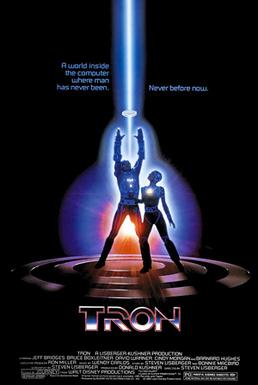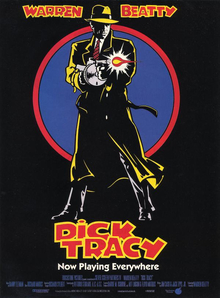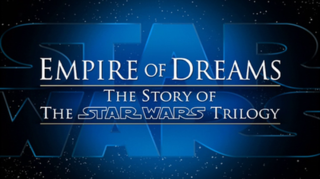Related Research Articles

Tron is a 1982 American science fiction action adventure film written and directed by Steven Lisberger from a story by Lisberger and Bonnie MacBird. The film stars Jeff Bridges as Kevin Flynn, a computer programmer and video game developer who is transported inside the software world of a mainframe computer where he interacts with programs in his attempt to escape; it also stars Bruce Boxleitner, David Warner, Cindy Morgan, and Barnard Hughes. Tron, along with The Last Starfighter, was one of cinema's earliest films to use extensive computer-generated imagery (CGI).

The Black Hole is a 1979 American science fiction film directed by Gary Nelson and produced by Walt Disney Productions. The film stars Maximilian Schell, Robert Forster, Joseph Bottoms, Yvette Mimieux, Anthony Perkins and Ernest Borgnine, while the voices of the main robot characters are provided by Roddy McDowall and Slim Pickens. The music for the film was composed by John Barry. With a production budget of $20 million, plus another $6 million for advertising, it was at the time the most expensive picture ever produced by Disney.

Dick Tracy is a 1990 American action crime film based on the 1930s comic strip character of the same name created by Chester Gould. Warren Beatty produced, directed and starred in the film, whose supporting cast includes Al Pacino, Madonna, Glenne Headly and Charlie Korsmo, with appearances by Dustin Hoffman, James Keane, Charles Durning, William Forsythe, Seymour Cassel, Mandy Patinkin, Catherine O'Hara, Ed O'Ross, James Caan, James Tolkan, R. G. Armstrong and Dick Van Dyke. Dick Tracy depicts the detective's romantic relationships with Breathless Mahoney and Tess Trueheart, as well as his conflicts with crime boss Alphonse "Big Boy" Caprice and his henchmen. Tracy also begins fostering a young street urchin named Kid.
John Charles Dykstra, A.S.C. is an American special effects artist, pioneer in the development of the use of computers in filmmaking and recipient of three Academy Awards, among many other awards and prizes. He was one of the original employees of Industrial Light & Magic, the special effects and computer graphics division of Lucasfilm. He is well known as the special effects lead on the original Star Wars, helping bring the original visuals for lightsabers, space battles between X-wings and TIE fighters, and Force powers to the screen. He also led special effects on many other movies, including Batman Forever, Batman & Robin, Stuart Little, X-Men: First Class, Spider-Man and Spider-Man 2.

A matte painting is a painted representation of a landscape, set, or distant location that allows filmmakers to create the illusion of an environment that is not present at the filming location. Historically, matte painters and film technicians have used various techniques to combine a matte-painted image with live-action footage (compositing). At its best, depending on the skill levels of the artists and technicians, the effect is seamless and creates environments that would otherwise be impossible or expensive to film. In the scenes, the painting part is static while movements are integrated on it.

Empire of Dreams: The Story of the Star Wars Trilogy is a 2004 documentary film directed by Kevin Burns and narrated by Robert Clotworthy. It documents the making of the original Star Wars trilogy: Star Wars (1977), The Empire Strikes Back (1980), and Return of the Jedi (1983), and their impact on popular culture.
Brian Johnson is a British designer and director of film and television special effects.
David Burroughs Mattingly is an American illustrator and painter, best known for his numerous book covers of science fiction and fantasy literature.
Albert J. Whitlock Jr. was a British-born motion picture matte artist best known for his work with Disney and Universal Studios.
The Visual Effects Society (VES) is an entertainment industry organization representing visual effects practitioners including artists, animators, technologists, model makers, educators, studio leaders, supervisors, PR/marketing specialists and producers in film, television, commercials, music videos, and video games. It has about 4,000 members in 42 countries. Since 2002 it has produced the Visual Effects Society Awards which honor the best work of the previous year in various categories.
William Samuel Cook "Peter" Ellenshaw was an English matte designer and special effects creator who worked on many Disney features. Born in London, he moved to America in 1953.

Craig Barron is an American visual effects artist and creative director at Magnopus, a media company that produces visual development and virtual production services for motion pictures, television, museums and multimedia platforms.
JP Trevor is a British conceptual artist best known for his surrealist and realist landscape painting and film design.

SP FX: The Empire Strikes Back is a television documentary special which originally aired on CBS on September 22, 1980. Hosted by actor Mark Hamill, it is a behind-the-scenes look at the creation of the special effects in the second Star Wars film, The Empire Strikes Back, which was released that year. The special was written by Richard Schickel and directed by Robert Guenette, who had both previously worked on the 1977 special The Making of Star Wars.
Michael Pangrazio is an American art director in the feature film industry best known for his matte painting work on Raiders of the Lost Ark and The Empire Strikes Back. As traditional and digital matte artist, he created some of the most famous matte paintings in movie history. His best known painting is the Raiders of the Lost Ark warehouse interior set-extension at the end of the movie.
Eustace Lycett was a British special effects artist who worked on attractions at Disneyland from the 1960s, such as Great Moments with Mr. Lincoln and Rocket to the Moon, as well as contributing to Disney animation.
Art Cruickshank was an American special effects artist who worked at both Disney and 20th Century Fox. Before he was in special effects he was a cameraman at Disney.
Frank Willard Van der Veer was an American optical and visual special effects artist who won a Special Achievement Academy Award at the 49th Academy Awards for Best Visual Effects for the film King Kong (1976). His career spanned over three decades from the 1950s until his death in the early 1980s, having participated in the Hollywood special effects industry with such other films as The Towering Inferno (1974), Killer Bees (1974), Logan's Run (1976), Star Wars (1977), 1941 (1979), Flash Gordon (1980), Clash of the Titans (1981) and Conan the Barbarian (1982).
The Empire Strikes Back is a 1980 American epic space opera film directed by Irvin Kershner, with a screenplay by Leigh Brackett and Lawrence Kasdan, based on a story by George Lucas. It is the sequel to Star Wars (1977), the second film in the Star Wars film series, and the fifth chronological chapter of the Skywalker Saga. Set three years after the events of Star Wars, its story follows the battle between the Galactic Empire led by Emperor Palpatine and the Rebel Alliance led by Princess Leia. Meanwhile, Luke Skywalker trains to master the Force so he can confront the Sith lord Darth Vader. The ensemble cast includes Mark Hamill, Harrison Ford, Carrie Fisher, Billy Dee Williams, Anthony Daniels, David Prowse, Kenny Baker, Peter Mayhew, and Frank Oz.
Joe Hale is an American animator and layout artist for Walt Disney Productions. He is best known for his debut producing credit for The Black Cauldron (1985).
References
- ↑ "Harrison Ellenshaw". www.RogerYostGallery.com.